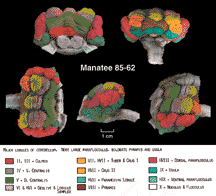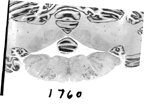The
cerebellum lies over the brainstem and behind or beneath the
caudal parts of the telencephalon. Like the cerebrum, the cerebellum
is covered with a thin sheet of cortex and it is found in all
vertebrates. In mammals and birds, the cerebellar cortex is
extremely convoluted, whereas in mammals the cerebral cortex
over the forebrain is relatively smooth in many animals (many
rodents, and to some extent the manatee).
 Eight
views of the cerebellum and brainstem of manatee 86-150 are
shown here. This block of brain tissue has been separated from
the forebrain to reveal all its external morphological details.
The cerebellar cortex is seen to be convoluted into numerous
folia or folds which are generally aligned in elongate form.
The different folia are grouped into several lobes and lobules,
such as anterior lobe, posterior lobe, the right and left hemispheres,
paraflocullus, floculus, and nodulus (not visible), paramedian
lobe, uvula.
Eight
views of the cerebellum and brainstem of manatee 86-150 are
shown here. This block of brain tissue has been separated from
the forebrain to reveal all its external morphological details.
The cerebellar cortex is seen to be convoluted into numerous
folia or folds which are generally aligned in elongate form.
The different folia are grouped into several lobes and lobules,
such as anterior lobe, posterior lobe, the right and left hemispheres,
paraflocullus, floculus, and nodulus (not visible), paramedian
lobe, uvula.
These subdivisions will be identified in the colored picture
and the black and white labeled photo panels below, together
with a brief list of references to the published literature.


A coronal section taken through the middle of the cerebellum
reveals not only the convoluted cerebellar cortex, but also
the deep nuclei of the cerebellum (fastigial, interpositus and
dendate nuclei) embedded in the white matter at the base of
the cerebellum, and overlying the medulla.

